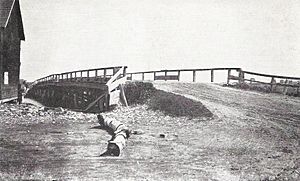Webhannet River facts for kids
The Webhannet River is a river in Wells, Maine. It is about 8.3 miles (13.4 km) long. All the water that flows into the river comes from a large area of land, about 8,963 acres (36.27 km²), entirely within the town of Wells.
The river has five smaller streams, called tributaries, that flow into it. Three of these streams have official names: Pope’s Creek, Depot Brook, and Blacksmith Brook. These streams flow through sandy land that was left behind by the last glacier. They run along the southern Maine coastline, behind the busy beaches of Wells and Drakes Island. The Webhannet River flows into Wells Harbor. From there, it empties into the Gulf of Maine, passing between two long structures called jetties.
A lot of the land around the Webhannet River is protected. About 1,510 acres (6.11 km²) are under conservation. This includes 1,167 acres (4.72 km²) of salt marsh and uplands, which are protected by the Rachel Carson National Wildlife Refuge. This helps keep the area healthy for many plants and animals.
Contents
What Are Jetties?
Jetties are long, wall-like structures built out into the water. They are usually made of large rocks. Their main job is to protect a harbor entrance or a river channel from waves and sand. They help keep the water deep enough for boats to pass safely.
Building the Wells Harbor Jetties
In 1961 and 1962, the United States Army Corps of Engineers built two jetties at the mouth of the Webhannet River. They built them to protect the channel leading into Wells Harbor, which needed to be about 8 feet (2.4 m) deep.
The north jetty was 580 feet (177 m) long, and the south jetty was 920 feet (280 m) long. They were built from the inner harbor out past the beaches. Workers used a lot of heavy stones to build them. First, a layer of smaller stones was put down. Then, two layers of very large stones were placed on top. Some of these stones weighed as much as two or three tons! In total, about 20,000 tons of stone were used for this first part of the project. This initial construction cost $95,600.
Extending the Jetties
The jetties were made even longer in the years that followed.
- In 1962 and 1963, the north jetty was extended another 200 feet (61 m) out into the sea. This cost $29,300.
- In 1965, both jetties were extended much further. The north jetty was made 1,225 feet (373 m) longer, and the south jetty was extended by 1,300 feet (396 m). This big extension used 119,000 tons of stone and cost $594,600.
How the Jetties Look Today
The extended parts of the jetties run parallel to each other. They are about 425 feet (130 m) apart. They end where the water is about eight feet deep at low tide. The jetties stand tall above the water, ranging from 13 feet (4 m) at their ends to 17 feet (5.2 m) on the north side and 16 feet (4.9 m) on the south side closer to land. The top of the jetties, where they are flat, is about 7 feet (2.1 m) wide at the seaward end and 5 feet (1.5 m) wide at the landward end.


